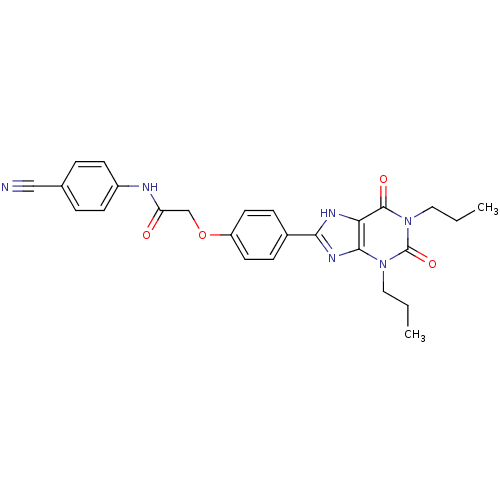Affinity DataKi: >290nMAssay Description:Binding affinity against Adenosine A3 receptor by displacement of specific binding of [125I]-AB-MECA in membranes prepared from CHO-A3 cellsMore data for this Ligand-Target Pair
Affinity DataKi: 570nMAssay Description:Binding affinity for human Adenosine A3 receptorMore data for this Ligand-Target Pair
Affinity DataKi: 570nMAssay Description:Displacement of [125I]AB-MECA from human adenosine A3 receptor expressed in CHO cellsMore data for this Ligand-Target Pair
Affinity DataKi: 570nMAssay Description:Antagonist activity against human adenosine A3 receptorMore data for this Ligand-Target Pair
Affinity DataKi: 570nMAssay Description:Displacement of [125I]IABA from recombinant human A3 adenosine receptor expressed in HEK293 cell membranes measured after 3 hrsMore data for this Ligand-Target Pair
Affinity DataKi: 570nMAssay Description:Binding affinity to human adenosine A3 receptorMore data for this Ligand-Target Pair
Affinity DataKi: 570nMAssay Description:Antagonist activity against human adenosine A3 receptor expressed in HEK cells in presence of [125]IAB-MECA or [125I]-IABA radioligand.More data for this Ligand-Target Pair
Affinity DataKi: 570nMAssay Description:Binding affinity to human adenosine A3 receptorMore data for this Ligand-Target Pair
Affinity DataKi: 575nMAssay Description:Binding affinity to recombinant human adenosine A3 receptorMore data for this Ligand-Target Pair
TargetAdenosine receptor A3(Rattus norvegicus)
Rheinische Friedrich-Wilhelms-Universitat Bonn
Curated by ChEMBL
Rheinische Friedrich-Wilhelms-Universitat Bonn
Curated by ChEMBL
Affinity DataKi: >1.00E+4nMAssay Description:Binding affinity to rat A3 adenosine receptorMore data for this Ligand-Target Pair
TargetAdenosine receptor A3(Mus musculus)
Rheinische Friedrich-Wilhelms-Universitat Bonn
Curated by ChEMBL
Rheinische Friedrich-Wilhelms-Universitat Bonn
Curated by ChEMBL
Affinity DataKi: >1.00E+4nMAssay Description:Displacement of [3H]NECA from recombinant mouse A3 adenosine receptor expressed in CHO cell membranes measured after 180 mins by liquid scintillation...More data for this Ligand-Target Pair

